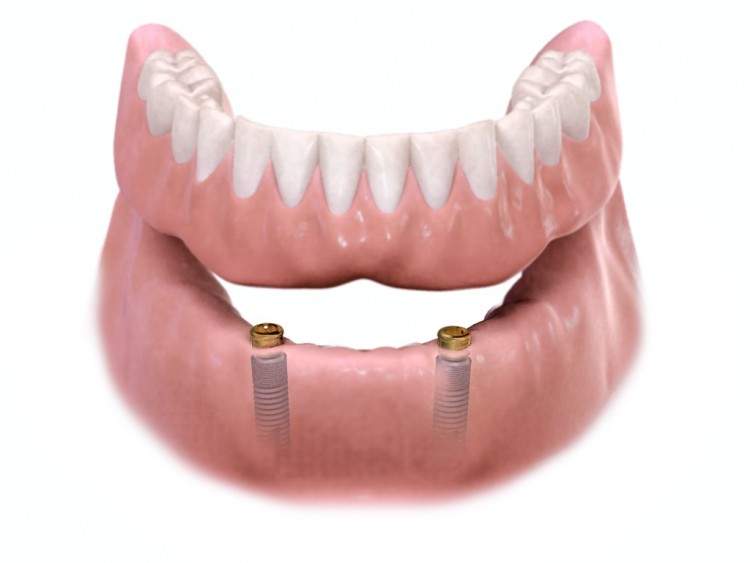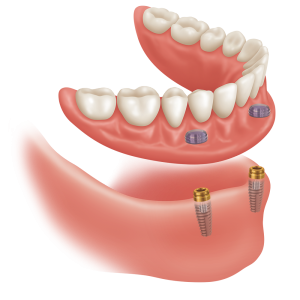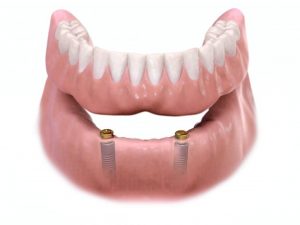
Removable Implant-Supported
Overdenture
Get Started Here
About Overdentures
Implant-supported overdenture is the most basic design for support of teeth. The prosthesis is supported by implants and gum tissue is easily removable by the patient. It may be supported by either two, three, or four dental implants. The more implants, the better the retention and stability of the denture. Overdentures with four implants are the most common option.
- Two Implants: This is the simplest and minimum number of implants for support of an overdenture. You will have great denture retention and can eat quite comfortably.
- Four Implants: This provides better support for your removable overdenture. Having four implants allows less denture extension, or flanges, and increases comfort dramatically. In some cases, a fixed prosthesis may be possible with four implants.
Advantages of a removable prosthesis:
- Less costly
- Good stability
- Patient can eat most types of foods comfortably
- Repair or modification is relatively simpler and less costly
Disadvantages of a removable prosthesis
- The removable denture may not be well tolerated by some patients due to presence of denture flanges.
- The prosthesis must be removed daily for hygiene
- May not be able to chew very hard foods as comfortably as with a fixed design
Is it Right For Me?
Dental implant-supported overdentures may be the right option for you if:
- You are using existing dentures and want to improve its support and retention
- You want to improve chewing your favorite food
- You don’t mind having teeth that are removable
- You have significant bone loss from use of dentures
- You need extraction of your remaining teeth and don’t want to use a conventional denture
- You want to preserve your jaw bone from further damage
- You don’t mind more denture flange extension covering the gum tissue and your palate
- You have limited budget

How Does It Work?
 The implants provide the support to the overlying dentures by special connectors known as locator abutments. The implants support the abutments which fit into their corresponding housing within base of the denture. The type of housing chosen by the dentist provides various degrees of friction and hence various levels of denture stability and and retention.
The implants provide the support to the overlying dentures by special connectors known as locator abutments. The implants support the abutments which fit into their corresponding housing within base of the denture. The type of housing chosen by the dentist provides various degrees of friction and hence various levels of denture stability and and retention.
Two dental implants provide mainly retention and prevention of vertical displacement. That means the denture can stay down quite well. However the denture can still rotate during chewing.
Three or four dental implants provide enhanced 3-dimensional stability offering both anti-displacement and anti-rotation benefits. Hence, you can eat food much more comfortably and not worry about denture displacement.
Treatment Stages and Process
The treatment is a collaborative effort between the oral surgeon and the restorative dentist. The oral surgeon offers expertise in placement of the dental implant and the restorative dentist will fabricate the actual teeth (overdenture). The treatment sequence is:
- The oral Surgeon obtains CBCT (cone beam CT Scan) to assess quality and quantity of bone.
- The restorative dentist completes clinical evaluation and takes impressions for study models and denture design, as well as assess the bite and aesthetic requirements. An interim denture is then fabricated and tried in the patient for proper fit and assure patient is happy with its aesthetics and design.
- The surgeon then uses the CBCT for a 3-dimensional computer assisted planning with virtual implant placement in the computer model of patient’s jaw bone. A surgical guide is then fabricated using 3-D printing.
- The surgeon places the dental implants using the surgical guide with optimal precision and accuracy. The implants are allowed to heal for 3-4 months. Patient continues using the transitional denture in the interim.
- The restorative dentist then takes final impressions and fabricates the final overdenture with housing that fits into the implant abutments. The bite is adjusted and the overdenture is checked for overall comfort, function, and aesthetics.
Patient Experience
Download Ebook on Full Arch Treatment Options

Treatment Cost
Basic Treatment Packages:
- Number of implants: 2-4
- Complete fee packages include all consultations, diagnostics, X-rays, 3-dimensional computer-assisted planning, CAM /CAD surgical guides, dental implants placement, transitional prosthesis, final restorations, anesthesia, and all follow-up appointments.
Removable Overdenture: From $13500
- 2 or 4 dental implants
- A removable overdenture supported by locator abutments that snap on top of the implants
- Provides good denture stability and eating function
- No more denture glue!
